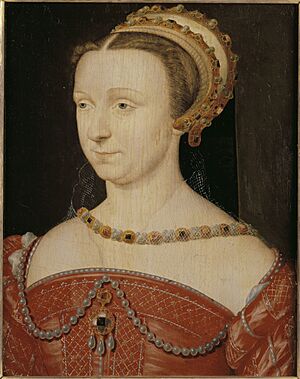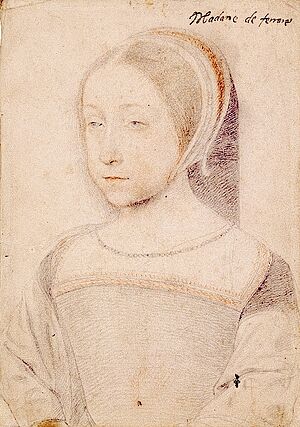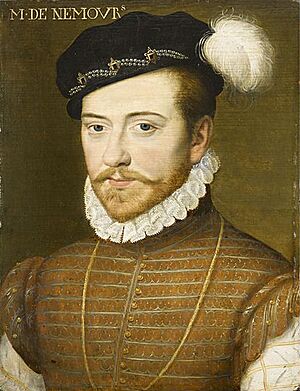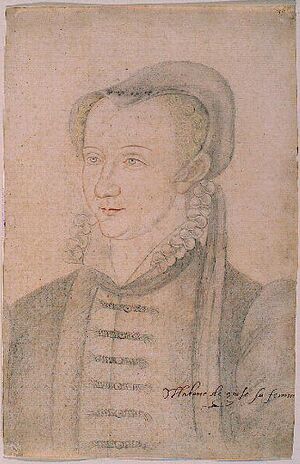Anna d'Este facts for kids
Quick facts for kids Anna d'Este |
|
|---|---|
| Duchess of Nemours prev Duchess consort of Guise |
|

Portrait by an unknown artist, 2nd half of the 16th century, oil on wood. Versailles, Musée du Château
|
|
| Born | 16 November 1531 Ferrara, Italy |
| Died | 17 May 1607 (aged 75) Paris, France |
| Spouse | |
| Issue | Henry I, Duke of Guise Catherine, Duchess of Montpensier Charles, Duke of Mayenne Louis II, Cardinal of Guise Charles Emmanuel, Duke of Nemours Henri I, Duke of Nemours |
| House | Este |
| Father | Ercole II d'Este |
| Mother | Renée of France |
Anna d'Este (born November 16, 1531 – died May 17, 1607) was an important princess. She had a lot of influence at the French royal court. She was also a key figure during the French Wars of Religion, which were a series of conflicts between Catholics and Protestants in France.
First, she was the Duchess of Aumale, then of Guise. Later, she became the Duchess of Nemours and Genevois through her second marriage.
Contents
Life Story
Anna d'Este was born on November 16, 1531. She was the oldest daughter of Duke Ercole II d'Este of Ferrara, Italy. Her mother was Renée of France, who was the daughter of King Louis XII of France.
Anna grew up in Ferrara and received an excellent education. A future writer and scholar named Olympia Fulvia Morata was one of her friends at court.
In 1548, after long talks, Anna's marriage was arranged. She was to marry Francis, Duke of Aumale, a French prince. The marriage contract was signed in Ferrara on September 28. The wedding took place near Paris on December 16. Anna never returned to Italy after that.
Because Anna was the granddaughter of King Louis XII, she was related to King Henry II of France and his sons.
Through her marriage, she joined the powerful Guise family. Also, because she was from Italy, she had close ties to the queen, Catherine de' Medici. These connections made her position at court very important.
After her father-in-law passed away in 1550, Anna became the Duchess of Guise. She managed the family's lands and their huge wealth. Her mother-in-law, Antoinette de Bourbon, helped her. Anna also worked as a go-between for the French court and her father's court in Ferrara. She had seven children, and four of them lived to be adults.
In February 1563, Francis, Duke of Guise, died tragically. Anna believed that Gaspard de Coligny, a leader of the French Protestants (Huguenots), was responsible. She tried for three years to get the king and his courts to agree with her. However, in January 1566, the king's council said Coligny was innocent. Many people at the time thought Anna was responsible for a later attack on Coligny in 1572. This event helped start the terrible St. Bartholomew's Day massacre.
On April 29, 1566, Anna married Jacques of Savoy. He was the Duke of Nemours and Genevois. After this, Anna spent most of her time in Annecy or traveling between her duchy of Genevois and the French court.
When political situations were difficult, she helped settle disagreements between her husband and the Duke of Savoy. She also kept her important role at the French court. Anna helped her sons advance in their careers. She also helped people who worked for her. She made sure she had a high place in official court ceremonies.
After her second husband passed away in 1585, Anna lived in Paris. She stayed in her large house, called the Hôtel de Nemours. When the Catholic League was formed, her sons played a big part in it. This made Anna even more important.
In December 1588, King Henry III of France ordered the deaths of Anna's two oldest sons. Anna d'Este herself was also held captive for a time. Some people at the time thought she was responsible for the king's death later on.
During the siege of Paris by Henry IV, the League called Anna "queen-mother." But after Henry IV became Catholic, she accepted him as king. She tried to convince her sons, who were still fighting, to do the same. In 1594, Anna went to Paris to show her respect to Henry IV.
Anna spent her last years in a respected position. She was the "superintendante de la maison" (head of the household) for Queen Marie de' Medici. However, she also faced growing debt and worried constantly about her children's and grandchildren's money problems.
Death
Anna d'Este passed away on May 17, 1607. At the time of her death, her personal belongings were worth only about 4000 livres. Parts of her were buried in Paris and Joinville. Her body was taken to Annecy and buried next to her second husband. Sadly, none of their tombs exist today.
Significance
Anna's life was similar to other princesses of her time regarding religious disagreements. Her mother was a Calvinist (Protestant). Her father, husbands, and sons were all Catholics. She helped King Henry IV gain acceptance after he became Catholic.
In other ways, she had a special place at the French court. This can be seen from the many lawsuits she was involved in. It was common for French nobles to be in legal disputes back then. However, Anna and her mother even challenged the king's right to Brittany. They did this by saying they were the daughter and granddaughter of a French king.
Family
Children from her marriage with Francis, Duke of Guise (1519–1563):
- Henry, Duke of Guise (1550–1588)
- Catherine, Duchess of Montpensier (1551–1596), married Louis, Duke of Montpensier
- Charles, Duke of Mayenne (1554–1611)
- Louis, Cardinal of Guise (1555–1588)
- Antoine (1557–1560)
- François (1559–1573)
- Maximilien (1562–1567/68)
Children from her marriage with Jacques de Savoie (1531–1585):
- Charles Emmanuel, Duke of Nemours (1567–1595)
- Marguerite (1569–1572)
- Henry I, Duke of Nemours (1572–1632)
- Emmanuel Philibert (died young)
See Also
- House of Guise
- French Wars of Religion
- Catherine de' Medici





